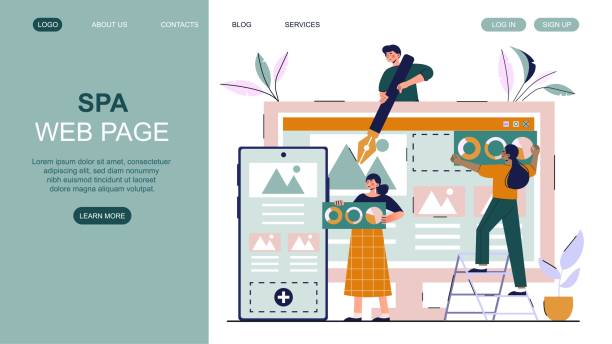Introduction to the Importance of Secure Web Design in Today’s World

In the current digital age, where a significant portion of our commercial, educational, and communication activities are conducted online, website security is of vital importance.
The concept of secure web design is no longer a luxury choice, but an undeniable necessity.
Websites, due to storing and processing a large volume of sensitive user information, including financial, personal, and commercial data, are constantly the primary target of online threats and cyberattacks.
The lack of secure web design can lead to catastrophic consequences such as data breaches, loss of business reputation, heavy financial losses, and even legal prosecution.
Cybersecurity is truly the backbone of user trust and online business stability.
Secure web design means implementing a set of procedures, technologies, and standards throughout all stages of the website development lifecycle, from initial design to deployment and maintenance.
This proactive approach not only protects the website against known attacks but also prepares it to counter emerging threats.
Ignoring these principles opens doors for intruders who can easily exploit vulnerabilities and gain access to critical information.
In this article, we delve deep into various aspects of secure web design and provide practical solutions for building websites that are resilient against cyber threats.
Our goal is to increase awareness and provide the necessary tools for developers and business owners to create a secure and reliable online environment for their users.
This is an educational and explanatory approach to understanding the foundation of a secure website.
Are you bothered by losing customers who visit your site to make a purchase?
Rasaweb is your specialized solution for having a successful online store.
✅ Significant increase in your online sales
✅ Building trust and professional branding with customers⚡ Get free consultation from Rasaweb experts!
Understanding Common Website Vulnerabilities and Countermeasures

To achieve secure web design, a deep understanding of common vulnerabilities that threaten websites is essential.
The OWASP (Open Web Application Security Project) organization continuously publishes a list of the top 10 web vulnerabilities (OWASP Top 10) which identifies the most common and critical weaknesses in web applications.
This list is a specialized reference for developers and security professionals.
Among these vulnerabilities is SQL Injection, which allows an attacker to inject malicious SQL code into website inputs to access or manipulate the database.
Protection against SQL Injection requires strict input validation and the use of parameterized queries.
Another vulnerability is Cross-Site Scripting (XSS), where an attacker injects malicious client-side scripts into legitimate web pages.
These scripts can steal sensitive user information such as cookies or modify web pages.
Countering XSS involves validating and sanitizing all user inputs before displaying them on the page.
Furthermore, Broken Authentication and Session Management allow attackers to steal user identities or take control of active sessions.
Using strong passwords, multi-factor authentication (MFA), and proper session management are among the key measures.
Finally, Insecure Deserialization and Security Misconfiguration are also critical issues that can lead to remote code execution and unauthorized access.
A secure web design and comprehensive approach requires an analytical and specialized approach to identify and address these vulnerabilities in the early stages of development, rather than after an attack has occurred.
Understanding these threats and implementing preventative solutions is a fundamental step towards creating a robust and reliable website.
Implementing Secure Coding Principles and Best Practices

One of the main pillars of secure web design is a special focus on secure coding principles.
This educational and guiding approach enables developers to write code from the outset that has the fewest vulnerabilities.
Input Validation is of paramount importance; every piece of data received from the user must be carefully checked and sanitized to prevent the injection of malicious code or unauthorized data.
Failure to do so can lead to attacks such as SQL Injection or XSS.
In the area of authentication and password management, passwords should never be stored in plain text.
Using strong and appropriate hashing functions like bcrypt along with salt for password storage is essential.
Additionally, implementing proper Access Control systems that operate based on the “Principle of Least Privilege” is crucial.
This principle states that every user or system should only have access to the minimum resources and operations necessary to perform their tasks.
Using secure frameworks and libraries can also help improve security, as these tools often have built-in security features that eliminate the need for developers to manually implement certain security mechanisms.
Also, Rate Limiting can prevent Brute Force and DDoS attacks.
Secure web design requires continuous security thinking throughout all development stages.
The table below shows some key differences between secure and insecure coding practices:
| Feature | Secure Coding | Insecure Coding |
|---|---|---|
| Input Validation | Always validates and sanitizes user input (e.g., filtering HTML tags, parameterizing queries). | No input validation, direct acceptance of data from the user. |
| Password Storage | Uses strong hashing functions and salt (e.g., bcrypt). | Stores passwords in plain text or weak hashes. |
| Session Management | Uses random and complex session IDs, session time limits. | Predictable session IDs, sessions without expiration. |
| Access Control | Implements the principle of least privilege, strict permission checking for each request. | Excessive access, no permission checking. |
| Error Reporting | Displays general errors to the user, logs error details securely. | Displays error details including file paths and database information to the user. |
The Critical Role of SSL/TLS Certificates and HTTPS Protocol in Web Security

In the modern web world, secure web design is almost inconceivable without the use of the HTTPS protocol.
HTTPS (Hypertext Transfer Protocol Secure) is the secure version of HTTP that encrypts the communication between the user’s browser and the website server using encryption protocols like SSL (Secure Sockets Layer) or its successor, TLS (Transport Layer Security).
This encryption provides three vital benefits for web security: Confidentiality, Integrity, and Authenticity.
Confidentiality means that information sent and received between the user and the website is unreadable to third parties.
This prevents attackers from eavesdropping on sensitive information such as passwords, credit card details, and personal data during transit.
Integrity ensures that the data has not been tampered with during transmission and is exactly what was sent.
This feature prevents Man-in-the-Middle (MITM) attacks where an attacker modifies information mid-route.
Authenticity assures users that they are connecting to the legitimate website and not a fake website created by an attacker.
This is guaranteed by an SSL/TLS certificate issued by a trusted Certificate Authority (CA).
Secure web design must be carried out with HTTPS in mind from the outset.
Browsers mark websites without HTTPS as insecure, which severely impacts user trust and SEO rankings.
Proper HTTPS implementation includes ensuring correct server configuration, using valid and up-to-date certificates, and redirecting all HTTP traffic to HTTPS.
This protocol not only provides a powerful security layer for your website but also sends a strong signal of your commitment to user privacy and security.
Therefore, every secure web design project should consider HTTPS as a fundamental and non-negotiable standard.
Does your current website build the trust that potential customers should have in your business? If the answer is no, it’s time to get your professional and impactful corporate website with Rasaweb.
✅ Fully customized design tailored to your brand identity
✅ Significant increase in lead generation and business credibility in the eyes of customers⚡ Contact us for a free consultation!
Protection Against Distributed Denial-of-Service (DDoS) Attacks

Distributed Denial-of-Service (DDoS) attacks are among the most destructive threats to website stability and availability.
In these types of attacks, attackers use a network of infected systems (botnets) to flood the target website or server with a massive volume of fake traffic.
The main goal of these attacks is to overwhelm server resources and bandwidth, thereby rendering the website inaccessible to real users.
Secure web design must include strategies for mitigating and countering these types of attacks.
This topic is a specialized and important guidance aspect in the field of web security.
One of the most effective methods for protecting against DDoS is the use of Content Delivery Network (CDN) services.
CDNs route incoming traffic through a network of distributed servers and can identify and filter malicious DDoS traffic before it reaches the website’s origin server.
Additionally, many CDNs offer advanced security features such as Web Application Firewalls (WAF) that can identify suspicious traffic patterns and block attacks.
Implementing anti-DDoS solutions includes precise configuration of firewall rules, setting Rate Limiting to prevent floods of requests from a single IP, and using traffic monitoring tools to identify unusual patterns.
At the infrastructure level, having sufficient bandwidth and scalable server resources can also help absorb smaller attack traffic.
However, for large and complex attacks, reliance on specialized DDoS Mitigation service providers is essential.
Secure web design is not only about secure coding but also involves planning to counter these external attacks.
A comprehensive strategy for ensuring web security must also include the ability for early detection and effective response to DDoS attacks to ensure the website is always available to users and provides an optimal user experience.
The Importance of Regular Security Audits and Penetration Testing

Secure web design is not a one-time process, but a continuous and evolving effort.
Even with strict adherence to all secure coding principles and implementation of best practices, new vulnerabilities can emerge over time or misconfigurations can occur.
Therefore, regular Security Audits and Penetration Testing are of critical importance.
These analytical and informative approaches help organizations actively assess their website’s security posture and identify and address weaknesses before attackers discover them.
Security Audits involve a comprehensive review of code, server configuration, network infrastructure, and operational procedures.
These audits can be performed automatically with vulnerability scanning tools or manually by experienced security professionals.
The main goal is to identify any errors or misconfigurations that could act as a security loophole.
In contrast, Penetration Testing is a controlled simulation of a real cyberattack performed by white-hat teams.
This process goes beyond merely identifying vulnerabilities and attempts to exploit them to infiltrate the system and assess the potential impact of a successful attack.
The results of these tests and audits include detailed reports of discovered vulnerabilities, their severity, and recommended solutions for remediation.
Using this information, the development team can systematically and efficiently address weaknesses.
This process not only contributes to the continuous improvement of secure web design but also assures organizations that they are resilient against the latest threats.
This is good news for any business that values its online security.
A comprehensive strategy for website security must include a regular schedule for conducting audits and penetration tests to ensure the long-term stability and security of the website.
Optimized User Identity and Access Management (IAM)

One of the most important aspects of secure web design is the implementation of a strong and efficient User Identity and Access Management (IAM) system.
This system ensures that only authorized users can access relevant resources and prevents unauthorized access.
This part of web security includes an important educational and guiding approach.
Strong password policies are the first step in IAM.
Users must be required to use long, complex, and unique passwords that include a combination of uppercase and lowercase letters, numbers, and symbols.
Also, encouraging regular password changes and preventing the reuse of old passwords is important.
Implementing Multi-Factor Authentication (MFA) provides an additional layer of security.
MFA requires more than one factor to verify a user’s identity, such as something they know (password), something they have (SMS code, hardware token), or something they are (fingerprint, facial recognition).
This prevents attacker intrusion even if the password is stolen.
Role-Based Access Control (RBAC) is also a key element in IAM.
Instead of granting access individually, permissions are defined based on users’ roles within the organization or system.
This approach simplifies access management and reduces the risk of granting excessive access.
Each user is limited to the minimum level of access necessary to perform their tasks, which is known as the principle of least privilege.
Additionally, logging access and continuous monitoring of user activities are vital for identifying suspicious patterns and unauthorized access attempts.
These logs can be very useful in analyzing security incidents and detecting intrusions.
Secure web design requires a smart and dynamic IAM system that can adapt to changes in roles and threats.
Below, a table comparing different authentication methods is provided:
| Authentication Method | Description | Security Level |
|---|---|---|
| Password (Single-Factor) | Only using username and password. | Low (Vulnerable to Brute Force and Phishing attacks) |
| Two-Factor Authentication (2FA) | Password + second factor (e.g., SMS code, authenticator app). | Medium to High (Significant security improvement over single-factor) |
| Multi-Factor Authentication (MFA) | Password + two or more other factors (e.g., SMS code + fingerprint). | High (Very resistant to various attacks) |
| Biometric Authentication | Use of physical or behavioral characteristics (e.g., fingerprint, facial recognition). | Medium to High (Requires precise implementation to prevent spoofing) |
| Single Sign-On (SSO) | One-time login for accessing multiple applications. | Medium (Security depends on the SSO system, but improves user experience) |
Adherence to Data Privacy and International Regulations

In a world where information has become the most valuable asset, secure web design means paying special attention to data privacy and adherence to international regulations.
This aspect of web security is a specialized yet topical issue that is gaining increasing importance every day.
Regulations such as GDPR (General Data Protection Regulation) in Europe, CCPA (California Consumer Privacy Act) in California, and other similar regulations worldwide, have established strict frameworks for the collection, processing, and storage of users’ personal data.
Ignoring these regulations can lead to heavy fines and loss of reputation.
Privacy by Design is a key principle in website security.
This means integrating privacy considerations into every stage of website design and development, not as an add-on feature, but as an integral component.
This includes Data Minimization, meaning collecting only the information that is truly necessary to provide services, and also full transparency regarding how data is used with users.
Privacy policies should be written in simple, understandable language and be easily accessible to users.
Additionally, implementing Consent Mechanisms for the collection and use of cookies and other personal data is of high importance.
Users must have the right to choose and be able to easily withdraw their consent.
Data protection also includes encrypting data at rest and in transit, as well as securely deleting unnecessary data.
A secure web design goes beyond preventing cyberattacks; it involves creating an online environment that respects users’ privacy rights and allows them to use web services with confidence.
Does your current site showcase your brand’s credibility as it should? Or does it drive potential customers away?
Rasaweb, with years of experience in designing professional corporate websites, is your comprehensive solution.
✅ A modern, beautiful, and brand-identity-aligned website
✅ Significant increase in lead and new customer acquisition
⚡ Contact Rasaweb now for a free corporate website design consultation!
Incident Response and Data Recovery Planning

Even with the best secure web design approaches, the probability of security incidents never reaches zero.
Hackers are constantly devising new methods of intrusion.
Therefore, a critical component of web security is having a strong Incident Response Plan and Disaster Recovery Plan.
These analytical and guiding approaches help organizations minimize damage and quickly return to normal in the event of a security breach or disaster.
The Incident Response Plan should include detailed steps for identification, containment, eradication, recovery, and lessons learned from a security incident.
The incident response team must have clear roles and responsibilities, have the necessary tools, and be adequately trained.
Rapid intrusion detection is vital; the later an intrusion is discovered, the greater the potential damage.
Monitoring tools and Intrusion Detection Systems (IDS) can be helpful at this stage.
Containment means isolating infected systems to prevent the spread of the attack.
This can involve disconnecting from the network, disabling services, or quarantining systems.
After containment, the eradication phase involves removing the attack vector and any vulnerabilities that led to the intrusion.
This phase may include cleaning systems, installing security patches, and changing passwords.
Recovery means restoring systems and data to normal operational status.
This is where regular and reliable backups play a crucial role.
Backups must be stored securely and tested regularly to ensure their recoverability.
Secure web design is incomplete without planning for these scenarios.
A disaster recovery plan also includes necessary measures to restore business operations after a larger catastrophic event, such as complete server or data center failure.
Regular practice of these plans increases team readiness and reduces response time in actual incidents.
The Future of Secure Web Design and Emerging Challenges

The future of secure web design is constantly evolving and will face numerous emerging challenges.
This section, with its thought-provoking and engaging content, explores potential trends and new threats that web security professionals must prepare for.
The emergence of advanced technologies like Artificial Intelligence (AI) and Machine Learning (ML) brings both new opportunities and threats.
On one hand, AI can help in identifying complex attack patterns and automating defensive processes, but on the other hand, attackers can also use AI to develop more intelligent and stealthy attacks, such as generating highly convincing phishing campaigns or targeted Brute Force attacks.
Quantum Computing is another potentially major challenge for current cryptographic security.
While still in its early stages, quantum computers in the future will be able to easily break many of the encryption algorithms used today to protect data.
This necessitates the development of Post-Quantum Cryptography that can withstand these future threats.
Increased use of APIs and Microservices has also introduced complexities in website security.
Each API is a potential new entry point for attackers and requires its own specific security strategies, including strong authentication, rate limiting, and meticulous monitoring.
Security in cloud and container environments (such as Docker and Kubernetes) has also become an increasingly specialized field due to the complexity and dynamism of these infrastructures.
Secure web design in the future will require a “Security as Code” approach, where security rules and configurations are managed and automated as part of the application code.
Also, continuous awareness and training for developers and users will be more vital than ever, as humans remain the weakest link in the security chain.
As technology advances, threats also become more sophisticated, requiring a proactive and flexible approach to web security.
Frequently Asked Questions
| Question | Answer |
|---|---|
| 1. What does secure web design mean? | Secure web design means creating a website that is resistant to cyberattacks and protects user and server data. |
| 2. Why is security important in website design? | To prevent data breaches, protect user privacy, maintain user trust, and avoid financial and reputational losses. |
| 3. What are the most common web vulnerabilities? | SQL Injection, Cross-Site Scripting (XSS), Cross-Site Request Forgery (CSRF), Broken Authentication, and Security Misconfiguration. |
| 4. How can SQL Injection be prevented? | By using Prepared Statements / Parameterized Queries, ORMs, and Input Validation. |
| 5. What is the role of HTTPS and SSL/TLS in website security? | HTTPS encrypts communication between the user’s browser and the server using the SSL/TLS protocol, preventing eavesdropping and data tampering. |
| 6. What measures should be taken to prevent XSS attacks? | Input validation, Output Encoding to prevent malicious code execution, and using Content Security Policy (CSP). |
| 7. What does a strong password policy include? | Mandating long passwords, a combination of uppercase and lowercase letters, numbers, and special characters, and preventing reuse. |
| 8. How does Two-Factor Authentication (2FA) help with security? | Even if the user’s password is compromised, the attacker cannot log in without access to the second authentication factor (such as an SMS code or authenticator app). |
| 9. What is a Web Application Firewall (WAF) and what is its use? | A WAF is a firewall that monitors and filters HTTP traffic between a web application and the internet to prevent common web attacks such as SQL Injection and XSS. |
| 10. Why is regular updating of software and libraries important? | Updates often include security patches to fix discovered vulnerabilities. Failure to update can expose the site to new attacks. |
And other services of Rasa Web Advertising Agency in the field of advertising
Economical Health Products Advertising with Sponsored Articles on Websites
How to Optimize Health Products Sponsored Articles for Local Search
Techniques for Writing Sponsored Articles for Organic Health Products
The Importance of Ingredient Description in Health Products Sponsored Ads
Sponsored Articles Focusing on Skin and Hair Consultation Services
And more than hundreds of other services in the field of online advertising, advertising consulting, and organizational solutions
Online Advertising | Advertising Strategy | Sponsored Article
🚀 Transform your business in the online world with “Rasaweb Afarin”, a leading digital marketing agency. From custom website design to comprehensive SEO and content marketing strategies, we offer intelligent solutions for your sustainable growth.
📍 Tehran, Mirdamad Street, next to Bank Markazi, Southern Kazeroon Alley, Ramin Alley, No. 6



